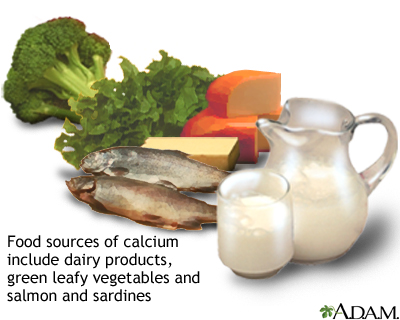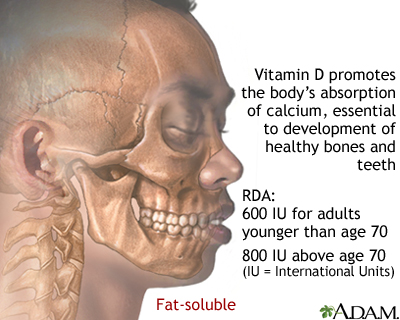What causes bone loss?
Osteoporosis, or weak bones, is a disease that causes bones to become brittle and more likely to fracture (break). With osteoporosis, the bones lose density. Bone density is the amount of calcified bone tissue that is in your bones.
Osteoporosis
Osteoporosis is a disease in which bones become fragile and more likely to break (fracture).

A diagnosis of osteoporosis means you are at risk for bone fractures even with everyday activities or minor accidents or falls.
Osteoporosis - Animation
If you've ever watched an apartment or office building under construction, you've seen the metal scaffolding that keeps the building standing upright. Inside your body, bones are the scaffolding that keep you standing upright. As you get older, these supports can weaken. And if they get too weak, you could wind up with a fracture. Let's talk about the bone-thinning condition called osteoporosis. Your internal scaffolding was built when you were young. Calcium and other minerals helped strengthen your bones, provided that you got enough of them from your diet. As you get older, those minerals can start to leech out of your bones, leaving them brittle, fragile, and easily breakable, a condition known as osteoporosis. Women over 50 are especially at risk for osteoporosis because during menopause they lose estrogen, which helps to keep bones strong. The tricky part about osteoporosis is that it's hard to tell you have it. You may not have any symptoms until you've already fractured a bone. Getting a bone density scan, which measures bone thickness, is one way to find out whether you have osteoporosis so you can start treatment right away if you need it. To keep your bones strong, try to get at least 1,200 milligrams of calcium daily, paired with 1,000 international units of vitamin D, which helps your body absorb calcium. You can eat foods that are high in these nutrients, like frozen yogurt, salmon, and low-fat milk, or, if you're not a big fan of fish or dairy, you can take supplements. Weight bearing exercise is also your ally when it comes to strengthening bones. A combination of weight bearing exercises like walking or playing tennis, plus strength training and balance exercises will reduce your risk of getting a fracture if you fall. You will want to get at least thirty minutes of exercise three times a week to see the benefits. And, stop smoking. Cigarette smoke both accelerates bone loss and blocks treatments from being as affective. If you've been diagnosed with osteoporosis, your doctor may recommend drugs called bisphosphonates to prevent further bone damage. Other medicines, including calcitonin, parathyroid hormone, and raloxifene are also treatment options. Don't let bone loss get so far along that you could have a disabling fracture from a minor fall. Start strengthening your bones with diet and exercise while you're still young. As you get older, talk to your doctor about bone density scans, and ask whether you need to take medicine if you're at risk for, or are starting to show signs of osteoporosis. And if your bones aren't as strong as they used to be, avoid falls by wearing shoes that fit well, and clearing clutter on the floor before it can trip you up, and bring you down.
Your Changing Bones
Your body needs the minerals calcium and phosphate to make and keep healthy bones.
- During your life, your body continues to both reabsorb old bone and create new bone. Your entire skeleton is replaced about every 10 years, though this process slows as you get older.
- As long as your body has a good balance of new and old bone, your bones stay healthy and strong.
- Bone loss occurs when more old bone is reabsorbed than new bone is created.
Sometimes bone loss occurs without any known cause. Some bone loss with aging is normal for everyone. Other times, bone loss and low bone density run in families and the disease is inherited. In general, white, older women are the most likely to have bone loss. This increases their risk of breaking a bone.
Brittle, fragile bones can be caused by anything that makes your body destroy too much bone, or keeps your body from making enough bone.
Weak bones can break easily, even without an obvious injury.
Bone mineral density is not the only predictor of how fragile your bones are. Consuming alcohol, smoking, and a sedentary lifestyle all increase the risk of having fragile bones. There are other unknown factors related to bone quality that are as important as bone quantity. Most bone density tests only measure the bone quantity.
Aging and Bone Loss
As you age, your body may reabsorb calcium and phosphate from your bones instead of keeping these minerals in your bones. This makes your bones weaker. When this process reaches a certain stage, it is called osteoporosis.
Osteoporosis - Animation
Osteoporosis is a condition that leads to loss of bone mass. From the outside, osteoporotic bone is shaped like normal bone. However, the inside of the bones becomes more porous during the aging process due to the loss of calcium and phosphate. The loss of these minerals makes the bones more prone to fracture even during routine activities, like walking, standing, or bathing. Often, a person will sustain a fracture before becoming aware of the presence of the disease. Prevention is the best measure for treating osteoporosis, by eating a recommended balanced diet including foods with sufficient amounts of calcium, phosphorous, and vitamin D. In addition, maintaining a regular exercise program as approved by your health care provider will help to keep the bones strong. Various medicines can be used as part of the treatment for osteoporosis and should be discussed thoroughly with your health care provider.
Many times, a person will fracture a bone before they even know they have bone loss. By the time a fracture occurs, the bone loss may be serious.
Women age 50 and older and men age 70 and older have a higher risk for osteoporosis than younger women and men.
- For women, a drop in estrogen at the time of menopause is a major cause of bone loss.
Menopause
Menopause is the time in a woman's life when her periods (menstruation) stop. Most often, it is a natural, normal body change that occurs between ag...
 ImageRead Article Now Book Mark Article
ImageRead Article Now Book Mark Article - For men, a drop in testosterone as they age can cause bone loss.
Your Lifestyle and Bone Loss
Your body needs calcium and vitamin D and enough exercise to build and keep strong bones.
Calcium and vitamin D
Getting enough calcium and vitamin D in your diet can help maintain bone strength and lessen your risk of developing osteoporosis.

Enough exercise
Osteoporosis is a disease that causes bones to become brittle and more likely to fracture (break). With osteoporosis, the bones lose density. Bone ...


Calcium source
Getting enough calcium to keep bones from thinning throughout a person's life may be made more difficult if that person has lactose intolerance or another reason, such as a tendency toward kidney stones, for avoiding calcium-rich food sources. Calcium deficiency also effects the heart and circulatory system, as well as the secretion of essential hormones. There are many ways to supplement calcium, including a growing number of fortified foods.

Vitamin D benefit
Vitamin D promotes absorption of calcium from the gut. Too much vitamin D may cause increased levels of calcium in the blood.
Your body may not make enough new bone if:
- You do not eat enough high-calcium foods
- Your body does not absorb enough calcium from the foods you eat
- Your body removes more calcium than normal in the urine
Certain habits can affect your bones.
- Drinking alcohol. Too much alcohol can damage your bones. It can also put you at risk of falling and breaking a bone.
- Smoking. Men and women who smoke have weaker bones. Women who smoke after menopause have an even higher chance of fractures.
Younger women who do not have menstrual periods for a long time also have a higher risk of bone loss and osteoporosis.
Low body weight is linked to less bone mass and weaker bones.
Exercise, especially weight-bearing exercise, is linked to higher bone mass and stronger bones.
Medical Disorders and Bone Loss
Many long-term (chronic) medical conditions can keep people confined to a bed or chair.
- This keeps the muscles and bones in their hips and spines from being used or bearing any weight.
- Not being able to walk or exercise may lead to bone loss and fractures.
Other medical conditions that may also lead to bone loss are:
- Rheumatoid arthritis
Rheumatoid arthritis
Rheumatoid arthritis (RA) is a disease that leads to inflammation of the joints and surrounding tissues. It is a long-term disease. It can also aff...
 ImageRead Article Now Book Mark Article
ImageRead Article Now Book Mark Article - Long-term (chronic) kidney disease
Long-term (chronic) kidney disease
Chronic kidney disease is the slow loss of kidney function over time. The main job of the kidneys is to remove wastes and excess water from the body...
 ImageRead Article Now Book Mark Article
ImageRead Article Now Book Mark Article - Overactive parathyroid gland
Overactive parathyroid gland
Hyperparathyroidism is a disorder in which 1 or more of the parathyroid glands in your neck produce too much parathyroid hormone (PTH).
 ImageRead Article Now Book Mark Article
ImageRead Article Now Book Mark Article - Diabetes, most often type 1 diabetes
- Organ transplant
Sometimes, medicines that treat certain medical conditions can cause osteoporosis. Some of these are:
- Hormone-blocking treatments for prostate cancer or breast cancer
- Some medicines that are used to treat seizures or epilepsy
- Glucocorticoid (steroid) medicines, if they are taken by mouth every day for more than 3 months, or are taken several times a year
Any treatment or condition that causes calcium or vitamin D to be poorly absorbed can also lead to weak bones. Some of these are:
- Gastric bypass (weight-loss surgery)
- Cystic fibrosis
- Other conditions that prevent the small intestine from absorbing nutrients well
People with eating disorders, such as anorexia or bulimia, are also at higher risk for osteoporosis.
Anorexia
Anorexia is an eating disorder that causes people to weigh less than is considered healthy for their age and height, usually by excessive weight loss...

Bulimia
Bulimia is an eating disorder in which a person has regular episodes of eating a very large amount of food (bingeing) during which the person feels a...

What's Next?
Talk to your health care provider about your risk for bone loss and osteoporosis. Find out how to get the right amount of calcium and vitamin D, what exercise or lifestyle changes are right for you, and what medicines you may need to take.
What medicines
Osteoporosis is a disease that causes bones to become brittle and more likely to fracture (break). With osteoporosis, the bones lose density. Bone ...

Reviewed By
Sandeep K. Dhaliwal, MD, board-certified in Diabetes, Endocrinology, and Metabolism, Springfield, VA. Also reviewed by David C. Dugdale, MD, Medical Director, Brenda Conaway, Editorial Director, and the A.D.A.M. Editorial team.
De Paula FJA, Black DM, Rosen CJ. Osteoporosis: basic and clinical aspects. In: Melmed S, Auchus RJ, Goldfine AB, Koenig RJ, Rosen CJ, eds. Williams Textbook of Endocrinology. 14th ed. Philadelphia, PA: Elsevier; 2020:chap 30.
Eastell R, Rosen CJ, Black DM, Cheung AM, Murad MH, Shoback D. Pharmacological management of osteoporosis in postmenopausal women: an Endocrine Society* Clinical Practice Guideline. J Clin Endocrinol Metab. 2019;104(5):1595-1622. PMID: 30907953 pubmed.ncbi.nlm.nih.gov/30907953/.
Weber TJ. Osteoporosis. In: Goldman L, Schafer AI, eds. Goldman-Cecil Medicine. 26th ed. Philadelphia, PA: Elsevier; 2020:chap 230.


 All rights reserved.
All rights reserved.